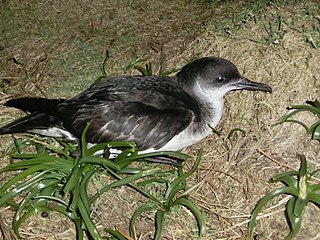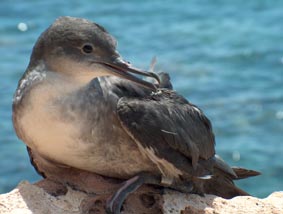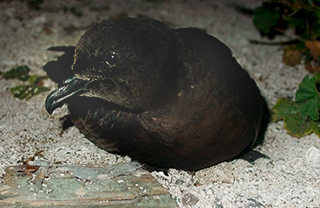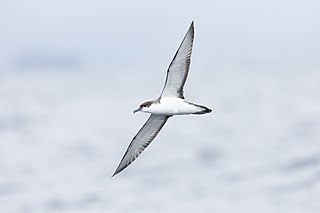
Procellariiformes is an order of seabirds that comprises four families: the albatrosses, the petrels and shearwaters, and two families of storm petrels. Formerly called Tubinares and still called tubenoses in English, procellariiforms are often referred to collectively as the petrels, a term that has been applied to all members of the order, or more commonly all the families except the albatrosses. They are almost exclusively pelagic, and have a cosmopolitan distribution across the world's oceans, with the highest diversity being around New Zealand.

Puffins are any of three species of small alcids (auks) in the bird genus Fratercula. These are pelagic seabirds that feed primarily by diving in the water. They breed in large colonies on coastal cliffs or offshore islands, nesting in crevices among rocks or in burrows in the soil. Two species, the tufted puffin and horned puffin, are found in the North Pacific Ocean, while the Atlantic puffin is found in the North Atlantic Ocean.

Shearwaters are medium-sized long-winged seabirds in the petrel family Procellariidae. They have a global marine distribution, but are most common in temperate and cold waters, and are pelagic outside the breeding season.

Petrels are tube-nosed seabirds in the bird order Procellariiformes.

The family Procellariidae is a group of seabirds that comprises the fulmarine petrels, the gadfly petrels, the diving petrels, the prions, and the shearwaters. This family is part of the bird order Procellariiformes, which also includes the albatrosses and the storm petrels.

The Manx shearwater is a medium-sized shearwater in the seabird family Procellariidae. The scientific name of this species records a name shift: Manx shearwaters were called Manks puffins in the 17th century. Puffin is an Anglo-Norman word for the cured carcasses of nestling shearwaters. The Atlantic puffin acquired the name much later, possibly because of its similar nesting habits.

The Balearic shearwater is a medium-sized shearwater in the seabird family Procellariidae. Puffinus is a Neo-Latin loanword based on the English "puffin" and its variants, that referred to the cured carcass of the fat nestling of the Manx shearwater, a former delicacy. The specific mauretanicus refers to Mauretania, an old name for an area of North Africa roughly corresponding to Morocco and Algeria. The Balearic Shearwater is listed critically endangered by the IUCN and is one of Europe's most endangered seabirds.

The great shearwater is a large shearwater in the seabird family Procellariidae. It breeds colonially on rocky islands in the south Atlantic. Outside the breeding season it ranges widely in the Atlantic.

The little shearwater is a small shearwater in the petrel family Procellariidae. Despite the generic name, it is unrelated to the puffins, which are auks, the only similarity being that they are both burrow-nesting seabirds.

The yelkouan shearwater, Levantine shearwater or Mediterranean shearwater is a medium-sized shearwater in the seabird family Procellariidae. It was formerly treated as a subspecies of the Manx shearwater.

Calonectris is a genus of seabirds. The genus name comes from Ancient Greek kalos, "good" and nectris, "swimmer".

Bulweria is a genus of seabirds in the family Procellariidae named after English naturalist James Bulwer. The genus has two extant species, Bulwer's petrel and Jouanin's petrel. A third species, the Olson's petrel, became extinct in the early 16th century; it is known only from skeletal remains. Bulwer's petrel ranges in the Atlantic, Indian and Pacific Oceans, whereas Joaunin's petrel is confined to the northwestern Indian Ocean. Olson's petrel is known from the Atlantic.

The wedge-tailed shearwater is a medium-large shearwater in the seabird family Procellariidae. It is one of the shearwater species that is sometimes referred to as a muttonbird, like the sooty shearwater of New Zealand and the short-tailed shearwater of Australia. It is found throughout the tropical Pacific and Indian Oceans, roughly between latitudes 35°N and 35°S. It breeds on the islands off Japan, on the Islas Revillagigedo, the Hawaiian Islands, the Seychelles, the Northern Mariana Islands, and off Eastern and Western Australia.

Procellaria is a genus of Southern Ocean long-winged seabirds related to prions, and within the order Procellariiformes. The black petrel ranges in the Pacific Ocean, and as far north as Central America. The spectacled petrel is confined to the Atlantic Ocean, and the Westland petrel to the Pacific Ocean. The white-chinned and grey petrel range throughout the higher latitudes of the Southern Ocean.

The flesh-footed shearwater is a medium-sized shearwater. Its plumage is black. It has pale pinkish feet, and a pale bill with a distinct black tip. Together with the equally light-billed pink-footed shearwater, it forms the Hemipuffinus group, a superspecies which may or may not have an Atlantic relative in the great shearwater. These large shearwaters are among those that have been separated into the genus Ardenna. Recent genetic analysis indicates evidence of strong divergence between Pacific colonies relative to those in South and Western Australia, thought to be explained by philopatry and differences in foraging strategies during the breeding season.

Buller's shearwater is a Pacific species of seabird in the family Procellariidae; it is also known as the grey-backed shearwater or New Zealand shearwater. A member of the black-billed wedge-tailed Thyellodroma group, among the larger shearwaters of the genus Ardenna, it forms a superspecies with the wedge-tailed shearwater.

The pink-footed shearwater is a species of seabird. The bird is 48 cm (19 in) in length, with a 109 cm (43 in) wingspan. It is polymorphic, having both darker- and lighter-phase populations. Together with the equally light-billed flesh-footed shearwater, it forms the Hemipuffinus group, a superspecies that may or may not have an Atlantic relative in the great shearwater. These are large shearwaters which are among those that could be separated in the genus Ardenna.

Ardenna is a genus of seabirds in the family Procellariidae. These medium-sized shearwater species were formerly included in the genus Puffinus.
Pterodromoides is an extinct genus of fulmarine petrel dating from the Late Miocene. It contains a single species, P. minoricensis. Its fossil remains were first discovered at the Punta Nati palaeontological site on the island of Menorca in the Balearic archipelago of the western Mediterranean. An additional specimen from North Carolina, USA has also been referred to this species, suggesting it lived across the North Atlantic. It was described in 2001, with the authors justifying the creation of a new genus by the large orbitonasal opening and characters of the postcranial skeleton, despite the similarity of the cranial osteology to that of Pagodroma.

































